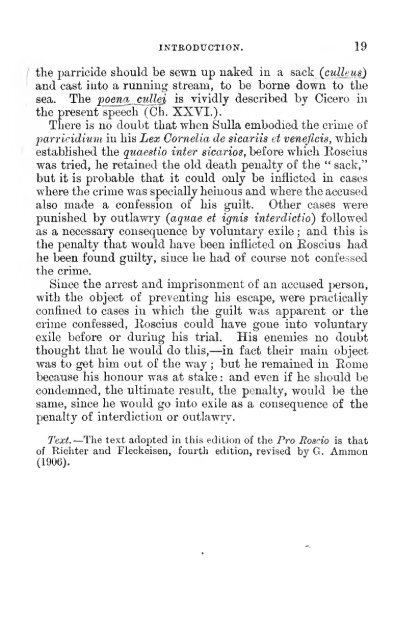Pro S. Roscio Amerino
Pro S. Roscio Amerino
Pro S. Roscio Amerino
Create successful ePaper yourself
Turn your PDF publications into a flip-book with our unique Google optimized e-Paper software.
] and<br />
INTRODTJCTION. 19<br />
/ the parricide sliould be sewn up naked in a sack (culleus)<br />
cast into a running stream, to be bome down to tlie<br />
s sea. The poena cullei is vividly described by Cicero in<br />
1 the present speech (Ch. XXVI.).<br />
There is no doubt that when SuUa embodied the crime of<br />
parricidium in his Lex Cornelia de sicariis et veneficis, which<br />
established the quaestio inter sicarios, before whicli Eoscius<br />
was tried, he retaiued tlie old death penalty of the " sack,"<br />
but it is probable that it could only be infiicted in cases<br />
where tlie crime was specially heiuous and where the accused<br />
also made a confession of his guilt. Other cases were<br />
punished by outlawry (aquae et ignis interdictio) foUowed<br />
as a necessary consequence by voluntary exile ; and this is<br />
the penalty that would have been inflicted on Eoscius had<br />
he been found guilty, since he bad of course not confessed<br />
the crime.<br />
Since the arrest and imprisonment of an accused person,<br />
with tlie object of preventing his escape, were practically<br />
confined to cases in which the guilt was apparent or the<br />
crime confessed, Roscius could have gone into voluntary<br />
exile before or duriug his trial. His enemies no doubt<br />
thought that he would do this,—in fact their main object<br />
was to get him out of the way ; but he remained in Eome<br />
and because his honour was at stake :<br />
even if he should be<br />
condemned, tlie ultimate result, the penalty, would be tbe<br />
same, since he would go into exile as a consequence of the<br />
penalty of interdiction or outlawry.<br />
Text.—The text adopted in this edition of the <strong>Pro</strong> <strong>Roscio</strong> is that<br />
of Richter and Fleckeisen, fourth edition, revised by G. Ammon<br />
(1906).

















